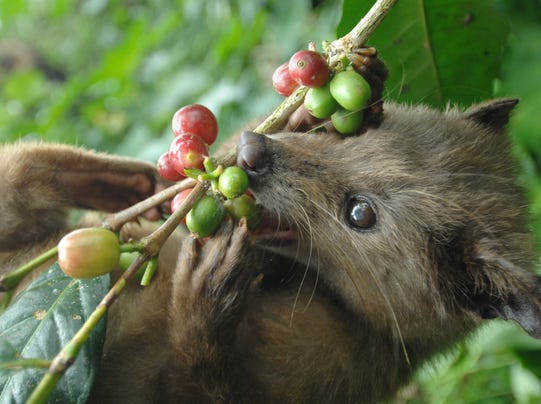It's often called the world's most expensive coffee. Even hotels in downtown Tokyo don't charge so much. The problem is that there is no standard methodology to know if you are getting actual cat poop coffee. As the business has grown, so has concern about fraud. What people with First World Problems worry about is if their cat poop coffee is the real deal. When paying $100-200 a pound you don't want to be duped, like you probably are with extra virgin olive oil and organic food.
A new paper has a solution; researchers have found what they call a "metabolic fingerprint" - metabolites they can detect using GC/MS - gas chromatography/mass spectrometry. They say they can use this method to differentiate citric acid, malic acid, and the inositol/pyroglutamic acid ratio and determine if the coffee is original Kopi Luwak, fake Kopi Luwak, regular coffee and a coffee blend containing 50% Kopi Luwak. It's proof of concept but certainly promising.

How the magic happens. Credit and link: DOI: 10.1021/jf401819s
People trying to sell you something claim that enzymes in the civet's stomach break down proteins in the beans, resulting in a smoother coffee, but there's no science to back that up. Instead, Cathy Payne writing in USA TODAY quotes Rocky Rhodes, president of International Coffee Consulting, who says the difference in taste is more related to the coffee cherries chosen - the civet picks the ripest coffee cherries because it wants to eat the best ones.
A peasant working for a buck a day is not going to be so selective.

You care about my diet? I am moved.(2) Credit: Sonny Tumbelaka, AFP/Getty Images. Link: USA Today
So obviously you could be getting real Kopi Luwak some day without the critter pooping all over it - if it's just the ripest berries, they will figure that out. Lots of good wines are made today using scientific methods rather than gut instincts too.
Citation: Udi Jumhawan, Sastia Prama Putri, Yusianto, Erly Marwani, Takeshi Bamba, and Eiichiro Fukusaki, 'Selection of Discriminant Markers for Authentication of Asian Palm Civet Coffee (Kopi Luwak): A Metabolomics Approach', J. Agric. Food Chem., 2013, 61 (33), pp 7994–8001
Publication Date (Web): July 27, 2013 DOI: 10.1021/jf401819s
(1) No, really. The Kopi Luwak is in the middle and the moonshine with cherries in it is on the right. The green stuff is an experiment - my neighbor postulated that she could make anything with spinach and no one would know the difference. So that is a Piña Colada.

Link: Facebook
She was right. It tasted the same. Her reward? An awesome Science 2.0 shirt (pictured below). The fact that she is holding a knife and has her forearm around her husband's neck in this picture makes this pretty funny. I guess I need to give him a coffee mug or something:

Link: Facebook
(2) Get it??? And there is another one in there I didn't put an endnote next to, because you people are smart enough to notice it anyway.





Comments